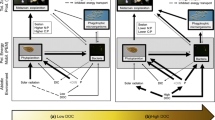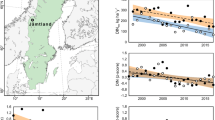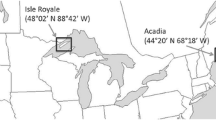Abstract
Two adjacent bays in a large oligotrophic lake (Georgian Bay, Lake Huron) were compared to determine how the inputs from relatively pristine, but moderately humic, tributaries may influence phytoplankton, nutrients and system metabolism. Dissolved organic carbon (DOC) concentrations decreased from 4 to 5 gC m−3 at inner sites to 2 gC m−3 or less at outer sites. The concentration gradient from inner to outer was greater in the bay with a major tributary, and optical properties (intensity and slope of light absorption spectrum) showed there was a loss of material with allochthonous characteristics along the gradient. Chlorophyll a (Chl a) and total phosphorus (TP) were also higher at inner (2–4 mg Chl a m−3 and 8–12 mgP m−3, respectively) than outer sites (≤1 mg Chl a m−3 and 4–5 mgP m−3). Chl a and TP, as well as particulate nutrient ratios (C:P, C:N, N:P), indicated significant eutrophication at inner sites, especially in the bay with the tributary, and there was a strong positive Chl a-phosphorus relationship. The stable oxygen isotope ratio (18O:16O) of dissolved oxygen indicated greater influence of biological oxygen fluxes at inner sites (where ratios were 2–3 ppt below atmospheric equilibrium) than at outer sites (where ratios were within 0.5 ppt of equilibrium). Community photosynthesis:respiration ratios inferred from 18O:16O varied positively with Chl a and inorganic nutrients, but negatively with DOC. Altered loading of allochthonous organic matter can be expected under changing climate and development scenarios and will have significant influence on optical properties and system metabolism through changes in DOC in this coastal system. The effects will nonetheless be strongly modulated by any accompanying change in inorganic nutrients.








Similar content being viewed by others
References
Alpine AE, Cloern JE (1988) Phytoplankton growth rates in a light-limited environment, San Francisco Bay. Mar Ecol Prog Ser 44:167–173
Anesio AM, Granéli W (2003) Increased photoreactivity of DOC by acidification: implications for the carbon cycle in humic lakes. Limnol Oceanogr 48:735–744
Austin J, Colman S (2008) A century of temperature variability in Lake Superior. Limnol Oceanogr 53:2724–2730
Bertilsson S, Stepanauskas R, Cuadros-Hansson R, Graneli W, Wikner J, Tranvik L (1999) Photochemically induced changes in bioavailable carbon and nitrogen pools in a boreal watershed. Aquat Microb Ecol 47:47–56
Biddanda BA, Cotner JB (2002) Love handles in aquatic ecosystems: the role of dissolved organic carbon drawdown, resuspended sediments, and terrigenous inputs in the carbon balance of Lake Michigan. Ecosystem 5:431–445
Blough NV, Del Vecchio R (2002) Distribution and dynamics of chromophoric dissolved organic matter (CDOM) in the coastal environment. In: Hansell DA, Carlson CA (eds) Biogeochemistry of marine dissolved organic matter. Academic Press, USA, pp 509–546
Bocaniov SA, Smith REH (2009) Plankton metabolic balance at the margins of very large lakes: temporal variability and evidence for dominance of autochthonous processes. Freshw Biol 54:345–362
Bocaniov SA, Schiff SL, Smith REH (2012) Plankton metabolism and physical forcing in a productive embayment of a large oligotrophic lake: insights from stable oxygen isotopes. Freshw Biol 57:481–496
Brown PC, Field JG (1986) Factors limiting phytoplankton production in a nearshore upwelling area. J Plank Res 8:55–68
Carignan R, Planas D, Vis C (2000) Planktonic production and respiration in oligotrophic shield lakes. Limnol Oceanogr 45:189–199
Carter JCH, Taylor WD, Tudorancea C (1995) A horizontal gradient in zooplankton community structure, and its implications for the relationships among mesozooplankton, microzooplankton and phytoplankton. Arch Hydrobiol 133:197–222
Cole JJ, Caraco NF, Peierls BL (1992) Can phytoplankton maintain a positive carbon balance in a turbid, freshwater, tidal estuary? Limnol Oceanogr 37:1608–1617
Cuthbert ID, del Giorgio P (1992) Towards a standard method of measuring color in freshwater. Limnol Oceanogr 37:1319–1326
deCatanzaro R, Chow-Fraser P (2011) Effects of landscape variables and season on reference water chemistry of coastal marshes in eastern Georgian Bay. Can J Fish Aquat Sci 68:1009–1023
delGiorgio PA, Peters RH (1994) Patterns in plankton P–R ratios in lakes—influence of lake trophy and dissolved organic carbon. Limnol Oceanogr 39:772–787
Demarty M, Prairie YT (2009) In situ dissolved organic carbon (DOC) release by submerged macrophyte-epiphyte communities in southern Quebec lakes. Can J Fish Aquat Sci 66:1522–1531
Depew D, Smith REH, Guildford S (2006) Production and respiration in Lake Erie plankton communities. J Gt Lakes Res 32:817–831
Donahue WF, Schindler DW, Page SJ, Stainton MP (1998) Acid-induced changes in DOC quality in an experimental whole-lake manipulation. Environ Sci Technol 32:2954–2960
El-Shaarawi AH, Munawar M (1987) The association of chlorophyll a and phytoplankton biomass in Lake Huron and Georgian Bay. Arch Hydrobiol Beih Ergebn Limnol 25:187–195
Emerson S, Stump C, Wilbur D, Quay P (1999) Accurate measurements of O2, N2, and Ar gases in water and solubility of N2. Mar Chem 64:337–347
Environment Canada (2010a) Water survey of Canada. Archived hydrometric data. http://www.wsc.ec.gc.ca/hydat/H2O/index_e.cfm. Accessed 10 July 2012
Environment Canada (2010b) National climate data and information archive. http://www.climate.weatheroffice.ec.gc.ca. Accessed 9 June 2011
Fahnenstiel GL, Lang GA, Nalepa TF, Johengen TH (1995) Effects of zebra mussel (Dreissena polymorpha) colonization on water quality parameters in Saginaw Bay, Lake Huron. J Gt Lakes Res 21:435–448
Fritz P, Frape SK, Drimmie RJ, Heemskerk AR (1986) Reply to comments by Grabczak et al. on “Water-rock interaction and chemistry of ground waters from the Canadian Shield”. Geochim Cosmochim Acta 50:1561–1563
Glooschenko WA, Moore JE, Munawar M, Vollenwieder RA (1974) Primary production in Lakes Ontario and Erie: a comparative study. J Fish Res Board Can 31:253–263
Gorham E (1996) Lakes under a three-pronged attack. Nature 381:109–110
Gray IM (1987) Differences between nearshore and offshore phytoplankton communities in Lake Ontario. Can J Fish Aquat Sci 44:2155–2163
Healey FP, Hendzel LL (1980) Physiological indicators of nutrient deficiency in Lake Phytoplankton. Can J Fish Aquat Sci 37:442–453
Helms JR, Stubbing A, Ritchie JD, Minor EC, Kieber DJ, Mopper K (2008) Absorption spectral slopes and slope ratios as indicators of molecular weight, source and photobleaching of chromophoric dissolved organic matter. Limnol Oceanogr 53:955–969
Hwang S-J, Heath RT (1999) Zooplankton bacterivory at coastal and offshore sites of Lake Erie. J Plankton Res 21:699–719
Johnson MG (1985) Acidification of Georgian Bay Rivers estimated by modifications of the Wright-Henriksen model. J Gt Lakes Res 11:163–170
Karlsson J, Jansson J, Jonsson A (2007) Respiration of allochthonous organic carbon in unproductive forest lakes determined by the Keeling plot method. Limnol Oceanogr 52:603–608
Kimmerer W (2005) Long-term changes in apparent uptake of silica in the San Francisco estuary. Limnol Oceanogr 50:793–798
Kirk JTO (1994) Optics of UV-B radiation in natural waters. Arch Hydrobiol 43:1–16
Köhler J (1995) Growth, production and losses of phytoplankton in the lowland River Spree: carbon balance. Freshw Biol 34:501–512
Lofgren BM, Quinn FH, Clites AH, Assel RA, Eberhardt AJ, Luukkonen CI (2002) Evaluation of potential impacts on Great Lakes water resources based on climate scenarios of two GCMs. J Gt Lakes Res 28:537–554
Morris DP, Zagarese H, Williamson CE, Balseiro EG, Hargreaves BR, Modenutti B, Moeller R, Queimalinos C (1995) The attenuation of solar UV radiation in lakes and the role of dissolved organic carbon. Limnol Oceanogr 40:1381–1391
Obernoster I, Benner R (2004) Competition between biological and photochemical processes in the mineralization of dissolved organic carbon. Limnol Oceanogr 49:117–124
Officer CR, Lynch DR (1981) Dynamics of mixing in estuaries. Estuar Coast Shelf Sci 12:525–533
Organization for Economic Co-Operation and Development OECD (1982) Eutrophication of waters. Monitoring, assessment and control, p 156
Ostrom NE, Carrick HJ, Twiss MR, Piwinski L (2005) Evaluation of primary production in Lake Erie by multiple proxies. Oecologia doi:10.1007/s00442-005-0032-5
Pace ML, Cole JJ, Carpenter SR, Kitchell JF, Hodgson JR, Van De Bogert MC, Bade DL, Kritzberg ES, Bastviken D (2004) Whole-lake carbon-13 additions reveal terrestrial support of aquatic food webs. Nature 427:240–243
Pace ML, Carpenter SR, Cole JJ, Coloso JJ, Kitchell JF, Hodgson JR, Middelburg JJ, Preston ND, Solomon CT, Weidel BC (2007) Does terrestrial organic carbon subsidize the plankton food web in a clear-water lake? Limnol Oceanogr 52:2177–2189
Prairie YT, Bird DE, Cole JJ (2002) The summer metabolic balance in the epilimnion of the southeastern Quebec lakes. Limnol Oceanogr 47:316–321
Quay PD, Wilbur DO, Richey JE, Devol AH, Benner R, Forsberg BR (1995) The 18O:16O of dissolved oxygen in rivers and lakes in the Amazon Basin: determining the ratio of respiration to photosynthesis rates in freshwaters. Limnol Oceonogr 40:718–729
Rao YR, Schwab DJ (2007) Transport and mixing between the coastal and offshore waters in the Great Lakes: a review. J Gt Lakes Res 33:202–218
Russ ME, Ostrom NE, Gandhi H, Ostrom PH, Urban NR (2004) Temporal and spatial variations in R:P ratios in Lake Superior, an oligotrophic freshwater environment. J Geophys Res 109(C10):S12. doi:10.1029/2003JC001890
Schiefer K, Schiefer K, Wiancko P (2006) Water quality monitoring report 2005. Township of Georgian Bay. A report prepared for the G. B. A. foundation by Bluewater Biosciences Inc., December 2006. http://www.georgianbay.ca/pdf/water_quality/Water%20Quality%20Monitoring%20Report-2006.pdf. Accessed 30 May 2010
Schindler DW, Bayley SE, Curtis PJ, Parker BR, Stainton MP, Kelly CA (1992) Natural and man-caused factors affecting the abundance and cycling of dissolved organic substances in Precambrian shield lakes. Hydrobiology 229:l–21
Schindler DW, Curtis PJ, Bayley SE, Parker BR, Beaty KG, Stainton MP (1997) Climate-induced changes in the dissolved organic carbon budgets of boreal lakes. Biogeochemistry 36:9–28
Scully NM, Lean DRS (1994) The attenuation of ultraviolet radiation in temperate lakes. Arch Hydrobiol 43135–43144
Smith EM, Prairie YT (2004) Bacterial metabolism and growth efficiency in lakes: the importance of phosphorus availability. Limnol Oceanogr 49:137–147
Smith REH, Allen CD, Charlton MN (2004) Dissolved organic matter and ultraviolet radiation penetration in the Laurentian Great Lakes and tributary waters. J Gt Lakes Res 30:367–380
Stephens BM, Minor EC (2010) DOM characteristics along the continuum from river to receiving basin: a comparison of freshwater and saline transects. Aquat Sci 72:404–417
Tranvik LJ (1998) Degradation of dissolved organic matter in humic waters by bacteria. In: Hessen D, Tranvik L (eds) Aquatic humic substances, ecological studies 33. Springer, Berlin, pp 259–283
Tzortziou M, Osburn CL, Neale PJ (2007) Photobleaching of dissolved organic material from a tidal marsh-estuarine system of the Chesapeake Bay. Photochem Photobiol 83:782–792
Urban NR, Auer MT, Green SA, Lu X, Apul DS, Powell KD, Bub L (2005) Carbon cycling in Lake Superior. J Geophys Res 110(C06):S90. doi:10.1029/2003JC002230
Venkitsewaran JJ, Wassenaar LI, Schiff SL (2007) Dynamics of dissolved oxygen isotopic ratios: a transient model to quantify primary production, community respiration and air-water exchange in aquatic ecosystems. Oecologia 153:385–398
Vinebrooke RD, Leavitt PR (1996) Effects of ultraviolet radiation on periphyton in an alpine lake. Limnol Oceanogr 41:1035–1040
Vinebrooke RD, Leavitt PR (1998) Direct and interactive effects of allochthonous dissolved organic matter, inorganic nutrients, and ultraviolet radiation on an alpine littoral food-web. Limnol Oceanogr 43:1065–1081
Vodacek A, Bloughl NV, DeGrandpre MD, Peltzer ET, Nelson RK (1997) Seasonal variation of CDOM and DOC in the middle Atlantic Bight: terrestrial inputs and photooxidation. Limnol Oceanogr 42:674–686
Wang X, Veizer J (2000) Respiration-photosynthesis balance of terrestrial aquatic ecosystems, Ottawa area, Canada. Geochim Cosmochim 64:3775–3786
Wang X, Depew D, Schiff S, Smith REH (2008) Photosynthesis, respiration and stable isotopes of oxygen in a large oligotrophic lake. Can J Fish Aquat Sci 65:2320–2331
Wassenaar LI, Koehler G (1999) An on-line technique for the determination of the delta O-18 and delta O-17 of gaseous and dissolved oxygen. Anal Chem 71:4965–4968
Weiler RR (1988) Chemical limnology of Georgian Bay and the north channel between 1974 and 1980. In: Munawar M (ed) Limnology and fisheries of Georgian Bay and the North Channel ecosystems, Kluwer Academic Publisher, Boston, p 77–84
Wetzel RG (1992) Wetlands as metabolic gates. J Gt Lakes Res 18:529–532
Wetzel RG (2001) Limnology: lake and river ecosystems, 3rd edn. Academic Press, San Diego
Wetzel RG, Likens GE (2000) Limnological analyses, 3rd edn. Springer, New York (pp 429)
Wilson KA, Howell ET, Jackson DA (2006) Replacement of zebra mussels by quagga mussels in the Canadian nearshore of Lake Ontario: the importance of substrate, round goby abundance and upwelling frequency. J Gt Lakes Res 32:11–28
Yan ND, Keller W, Scully NM, Lean DRS, Dillon PJ (1996) Increased UV-B penetration in a lake owing to drought-induced acidification. Nature 381:141–143
Author information
Authors and Affiliations
Corresponding author
Rights and permissions
About this article
Cite this article
Bocaniov, S.A., Barton, D.R., Schiff, S.L. et al. Impact of tributary DOM and nutrient inputs on the nearshore ecology of a large, oligotrophic lake (Georgian Bay, Lake Huron, Canada). Aquat Sci 75, 321–332 (2013). https://doi.org/10.1007/s00027-012-0276-1
Received:
Accepted:
Published:
Issue Date:
DOI: https://doi.org/10.1007/s00027-012-0276-1




